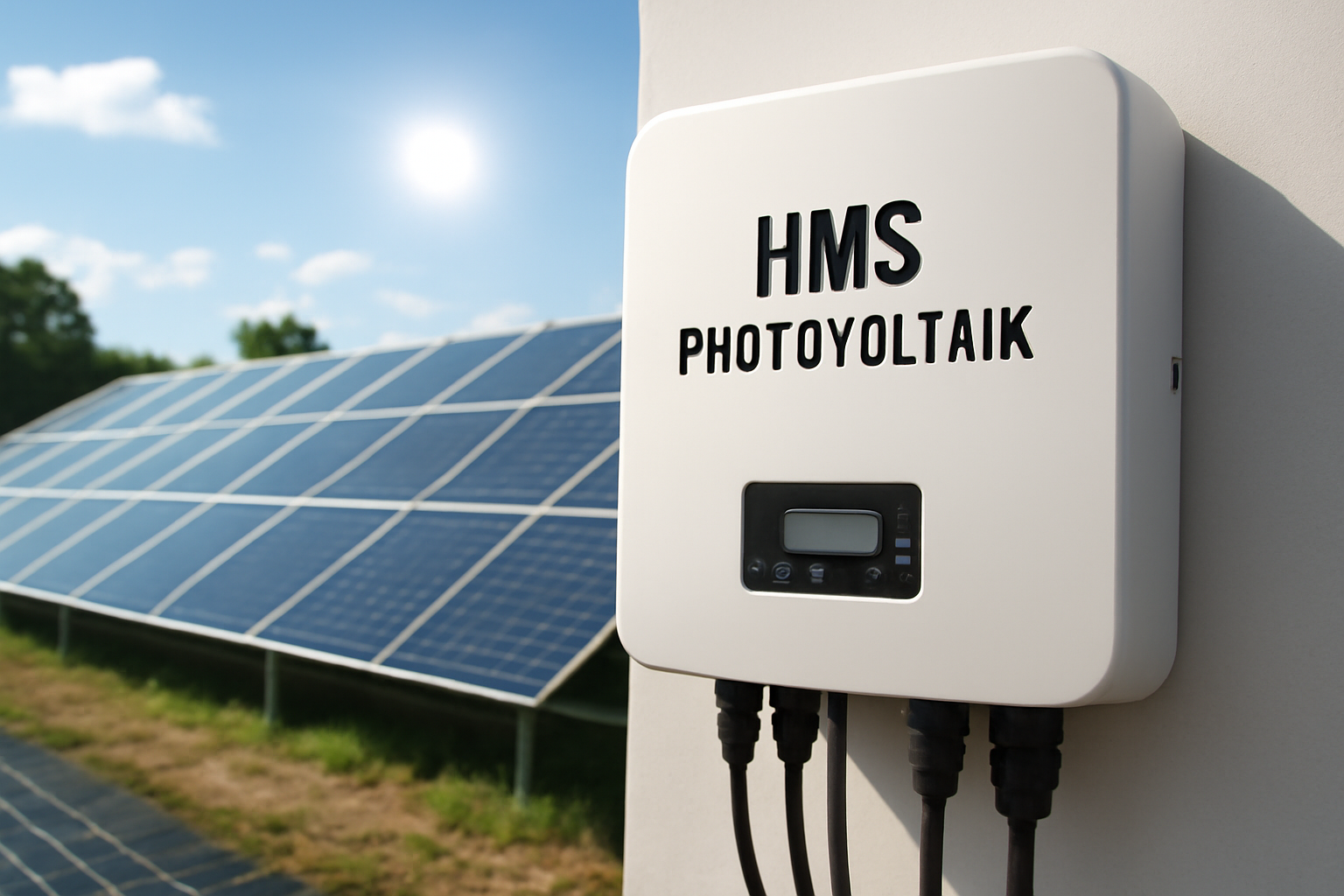In the world of renewable energy, solar power continues to grow rapidly as more homes and businesses look for clean, efficient, and cost-saving electricity solutions. Among the technologies helping solar energy become more reliable and accessible, HMS Photovoltaik has gained strong attention.
HMS Photovoltaik refers to a modern system built around microinverters, designed to improve the performance, safety, and flexibility of solar panels. With smart technology, strong monitoring features, and improved power generation, this system offers a new level of efficiency for solar installations.
Understanding HMS Photovoltaik technology is important, especially for those planning to invest in solar energy. Whether you are a homeowner wanting lower energy bills or a business aiming for sustainability, this system promises reliable and high-quality performance.
Its advanced design helps make solar power simpler, safer, and more productive. In the following sections, we will explore how HMS Photovoltaik works, its benefits, differences from traditional systems, and why it is considered the future of modern solar power.
What HMS Photovoltaik Technology Means in Modern Solar Energy?
HMS Photovoltaik refers to a system that uses module-level microinverters instead of a single central inverter. In simple terms, this means each solar panel has its own device to convert sunlight into usable electricity. This approach improves energy production by allowing panels to work independently instead of depending on one central system. When one panel faces shade or dirt, only that panel is affected, while others continue working efficiently.
This technology plays a key role in modern solar setups because it gives users better control and visibility. The system lets users monitor each panel individually, making it easier to understand performance, detect issues, and plan maintenance. With digital monitoring tools, owners can check their solar energy production in real time from a smartphone or computer.
HMS Photovoltaik systems are designed to support both small installations and large solar projects. Their flexibility makes them suitable for homes, offices, commercial buildings, and industrial sites. As solar energy grows, more people are choosing this technology because it delivers better results and optimizes every panel’s performance.
In today’s world, where energy efficiency and long-term value matter more than ever, HMS Photovoltaik stands out as a smart and future-ready option for solar power users.
How HMS Microinverters Improve Solar Panel Efficiency and Output?
Microinverters in the HMS Photovoltaik system work at the panel level, converting DC electricity to AC directly on the roof. This reduces energy loss and increases overall power output. Traditional systems experience more efficiency loss when power travels through long wires, but microinverters minimize this waste. As a result, users get more usable power from their solar panels every day.
One important benefit of HMS microinverters is their ability to handle partial shading. In many situations, trees, chimneys, or nearby buildings may cast shade on one part of a roof. With this technology, only the shaded panel loses power while others continue to work. This ensures consistent energy production throughout the day and across different weather conditions.
Microinverters also improve performance in real-life situations where panels may not always be perfectly aligned. Roof shapes, angles, and direction can affect how much sunlight panels receive. Because microinverters work independently, each panel generates the best results based on its position and sunlight exposure.
The technology also helps extend the lifespan of solar systems. Since microinverters balance the load across individual panels, they reduce stress on components. With more efficient performance and better management, HMS Photovoltaik systems deliver strong power output and long-term reliability.
Comparing HMS Microinverters With Traditional String Inverters
Traditional string inverters connect multiple solar panels together in a series, meaning all panels depend on a single inverter. If one panel underperforms, it reduces the power of the entire system. HMS microinverters remove this limitation by allowing each panel to operate independently. This creates a more efficient and flexible solar setup.
Another key difference is monitoring capability. With traditional systems, users can only track the total output from the entire array. Microinverters provide panel-level monitoring, giving deeper insights into performance and making troubleshooting easier. Users can quickly identify issues such as shading, dirt, or malfunctioning panels.
From a safety perspective, microinverters offer low-voltage DC operation, which reduces fire risk. Traditional string systems operate at high DC voltage, which can be more hazardous during maintenance or emergencies. This makes HMS Photovoltaik a preferred choice for homes and commercial properties prioritizing safety.
While traditional inverters may have lower upfront cost, microinverters often provide better long-term value. The increased efficiency, longer lifespan, improved monitoring, and easier maintenance make HMS Photovoltaik an appealing upgrade for modern solar installations.
Benefits of Using HMS Photovoltaik Systems for Homeowners and Businesses
Homeowners benefit greatly from HMS Photovoltaik systems because they can maximize their energy savings. Even when there are changes in sunlight or minor panel issues, the system maintains strong output. This means more reliable performance and better utility bill reduction over time. The ability to monitor energy production panel-by-panel gives users confidence and transparency.
For businesses, the technology supports larger installations and helps maintain consistent performance across wide rooftop spaces. Microinverters reduce production loss and help companies achieve sustainability goals. With growing global focus on green energy, this system supports eco-friendly business operations while keeping long-term energy costs low.
Another major advantage is flexibility in design and future expansion. Homeowners and businesses can easily add more panels later without reconfiguring the entire system. This makes HMS Photovoltaik ideal for customers who plan to expand their solar capacity in the future.
Reliability is another strong benefit. Because each panel works independently, system failures are rare. If a single panel or inverter needs attention, the rest continue operating normally. This ensures stable power generation and smooth operation throughout the system’s lifetime.
Improved Safety Features Provided by HMS Photovoltaik Technology
Safety is one of the most important reasons people choose HMS Photovoltaik. Microinverters operate at low DC voltage, which significantly reduces the risk of electrical fires. This makes them safer for homes, schools, offices, and commercial buildings. Electricians and maintenance teams also prefer microinverters due to easier and safer handling.
In addition to lower voltage operation, HMS systems come with advanced shutdown technology. This means that in emergencies or maintenance situations, each panel can be safely turned off at the module level. This level of control enhances protection for buildings and technicians.
Real-time monitoring also contributes to safety. By keeping track of each panel, users can quickly detect and respond to unusual behavior, such as overheating or wiring problems. Early detection minimizes risks and ensures long-term system health.
Overall, HMS Photovoltaik systems prioritize user safety while delivering strong performance. This combination makes them a secure and trusted solution for anyone investing in solar energy.
Installation Requirements for HMS Photovoltaik Systems Explained
Installing an HMS Photovoltaik system is generally straightforward and follows standard solar installation procedures. However, it requires proper planning and qualified technicians. Each panel receives its own microinverter, which must be mounted securely and connected correctly. This process ensures safe and efficient operation of the system.
Installers usually begin by studying the roof structure, sunlight direction, and available space. They then design the layout to maximize performance and airflow. Microinverters are attached behind each panel, and cables are connected to the electrical system. With clear instructions and modern tools, trained professionals complete installation efficiently.
One advantage of HMS systems is flexibility. Unlike traditional systems that require matching strings and panel groups, microinverters allow mixed panel types and different orientations. This means even complex roof shapes can benefit from solar power without performance loss.
While DIY installation is not recommended due to safety and electrical requirements, professional installers ensure compliance with local regulations and standards. Once installed, the system is configured for monitoring, allowing users to track performance instantly.
Future Developments and Innovations in HMS Photovoltaik Technology
Solar technology continues to evolve, and HMS Photovoltaik is expected to play a major role in the future of energy. With increasing global demand for clean energy, companies are improving microinverter designs to deliver even higher efficiency, longer lifespan, and smarter monitoring. Enhanced digital tools and mobile apps will allow users to manage energy production with greater control and convenience.
One exciting trend is the integration of HMS systems with batteries and smart home technology. This will allow homeowners and businesses to store energy, manage power usage, and become more energy independent. With electric vehicles becoming mainstream, HMS solar systems are also likely to connect more easily with EV charging systems.
In addition, innovations in heat management, reliability, and durability will help microinverters perform strongly in extreme environments. As technology becomes more widespread, production costs may decrease, making HMS systems even more accessible for global users.
With growing awareness of climate change and government support for renewable energy, HMS Photovoltaik systems are positioned to lead the future of modern solar power solutions.
Conclusion: Why HMS Photovoltaik Is a Smart Investment for Future-Ready Solar Energy?
HMS Photovoltaik brings a powerful combination of efficiency, safety, and long-term value to solar energy users. With microinverters working at the panel level, energy production becomes more reliable and consistent, even when conditions change.
The ability to monitor each panel, expand systems easily, and enjoy safer operation makes this technology a preferred choice for both homes and businesses. As the world continues moving toward cleaner and smarter energy solutions, systems like HMS Photovoltaik will play an essential role.
Choosing this technology means investing not just in solar power, but in a better, more efficient, and future-ready energy system. For anyone considering solar installation today, HMS Photovoltaik stands out as a wise and forward-looking decision.
FAQs
1. What is HMS Photovoltaik and how does it work?
HMS Photovoltaik uses microinverters at each solar panel, allowing individual panel performance monitoring and improved energy efficiency.
2. Are HMS microinverters better than string inverters?
Yes, HMS microinverters provide higher efficiency, increased safety, and module-level monitoring, especially in varied sunlight conditions.
3. Can I expand my solar system later with HMS Photovoltaik?
Absolutely. HMS systems offer flexible scalability, making it easy to add more panels in the future.
4. Are HMS Photovoltaik systems good for home and commercial use?
Yes, they are ideal for both residential and commercial installations due to their efficiency, safety, and long-term performance.
5. Do HMS Photovoltaik systems require special maintenance?
Microinverters require minimal maintenance. Routine cleaning and occasional system checks ensure smooth operation.
My name is Mustafa, and I have been blogging for over 5 years. I am passionate about sharing complete, accurate, and helpful information with my readers. Along with managing content on The Matcha Read, I also contribute blog posts to premium websites. My goal is to provide valuable insights in a clear and easy-to-understand way, so every reader walks away with useful knowledge.










